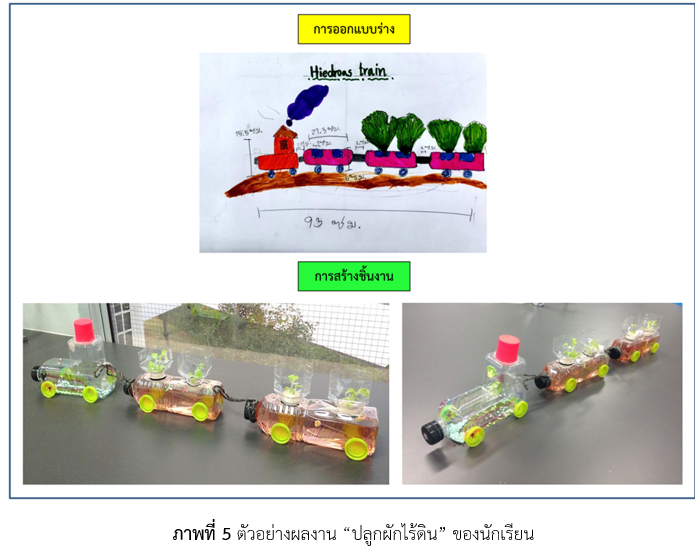การเรียนรู้ตามแนวทางสะตีมศึกษาที่เน้นกระบวนการออกแบบเชิงวิศวกรรม เรื่อง “ปลูกผักไร้ดิน” เพื่อเสริมสร้างทักษะที่จำเป็นในศตวรรษที่ 21 สำหรับนักเรียนประถมศึกษาตอนปลาย
Main Article Content
บทคัดย่อ
สะตีมศึกษา (STEAM Education) เป็นการจัดการเรียนรู้แบบบูรณาการด้านวิทยาศาสตร์ (Science) เทคโนโลยี (Technology) กระบวนการทางวิศวกรรม (Engineering) ศิลปะ (Arts) และคณิตศาสตร์ (Mathematics) ผสานเข้าด้วยกัน เพื่อให้ผู้เรียนสามารถเชื่อมโยงความรู้และทักษะต่าง ๆ ทั้งศาสตร์และศิลป์ไปพร้อมกัน ไปใช้ในการคิดและแก้ปัญหาอย่างสร้างสรรค์ในชีวิตจริง ผ่านการทำกิจกรรมการเรียนรู้โดยใช้โครงงานเป็นฐาน หรือ การเรียนรู้โดยใช้ปัญหาเป็นฐาน สามารถนำความรู้มาออกแบบวิธีการหรือกระบวนการในการคิดและการแก้ปัญหาเพื่อให้ได้เทคโนโลยีซึ่งเป็นผลผลิตจากกระบวนการออกแบบเชิงวิศวกรรมและพัฒนาทักษะในศตวรรษที่ 21 ซึ่งสอดคล้องกับแผนการศึกษาแห่งชาติ พ.ศ. 2560-2579 ที่กำหนดยุทธศาสตร์และเป้าหมายของการจัดการศึกษาเพื่อมุ่งเน้นให้ผู้เรียนมีทักษะและคุณลักษณะที่จำเป็นในศตวรรษที่ 21 อาทิ ทักษะการคิดอย่างมีวิจารณญาณและการแก้ปัญหา ทักษะการคิดสร้างสรรค์ ทักษะการสื่อสาร และทักษะการทำงานร่วมกันเป็นทีม ดังนั้นในบทความนี้ ผู้เขียนมุ่งนำเสนอแนวทางการจัดกิจกรรมการเรียนรู้ตามแนวทางสะตีมศึกษาเรื่อง “ปลูกผักไร้ดิน” สำหรับนักเรียนระดับชั้นประถมศึกษาตอนปลายที่เน้นการคิดและแก้ปัญหาโดยใช้กระบวนการออกแบบเชิงวิศวกรรมตามแนวทางของสถาบันส่งเสริมการสอนวิทยาศาสตร์และเทคโนโลยี (สสวท.) ประกอบด้วย 6 ขั้นตอน ได้แก่ 1) ระบุปัญหา 2) รวบรวมข้อมูลและแนวคิดเพื่อสรรหาวิธีการที่เป็นไปได้ 3) เลือกและออกแบบวิธีการแก้ปัญหา 4) ดำเนินการแก้ปัญหาเพื่อสร้างต้นแบบ 5) ทดสอบ ประเมินผล และปรับปรุงแก้ไขต้นแบบ 6) นำเสนอต้นแบบ วิธีการ และผลการแก้ปัญหา โดยมุ่งเน้นให้นักเรียนสามารถบูรณาการความรู้และทักษะในสะตีมศึกษาสำหรับการคิดและแก้ปัญหาอย่างสร้างสรรค์ได้อย่างเป็นขั้นตอน และเกิดการเสริมสร้างทักษะที่จำเป็นในศตวรรษที่ 21
Article Details

อนุญาตภายใต้เงื่อนไข Creative Commons Attribution-NonCommercial-NoDerivatives 4.0 International License.
วารสารวิทยาศาสตร์และวิทยาศาสตร์ศึกษา (JSSE) เป็นผู้ถือลิสิทธิ์บทความทุกบทความที่เผยแพร่ใน JSSE นี้ ทั้งนี้ ผู้เขียนจะต้องส่งแบบโอนลิขสิทธิ์บทความฉบับที่มีรายมือชื่อของผู้เขียนหลักหรือผู้ที่ได้รับมอบอำนาจแทนผู้เขียนทุกนให้กับ JSSE ก่อนที่บทความจะมีการเผยแพร่ผ่านเว็บไซต์ของวารสาร
แบบโอนลิขสิทธิ์บทความ (Copyright Transfer Form)
ทางวารสาร JSSE ได้กำหนดให้มีการกรอกแบบโอนลิขสิทธิ์บทความให้ครบถ้วนและส่งมายังกองบรรณาธิการในข้อมูลเสริม (supplementary data) พร้อมกับนิพนธ์ต้นฉบับ (manuscript) ที่ส่งมาขอรับการตีพิมพ์ ทั้งนี้ ผู้เขียนหลัก (corresponding authors) หรือผู้รับมอบอำนาจ (ในฐานะตัวแทนของผู้เขียนทุกคน) สามารถดำเนินการโอนลิขสิทธิ์บทความแทนผู้เขียนทั้งหมดได้ ซึ่งสามารถอัพโหลดไฟล์บทความต้นฉบับ (Manuscript) และไฟล์แบบโอนลิขสิทธิ์บทความ (Copyright Transfer Form) ในเมนู “Upload Submission” ดังนี้
1. อัพโหลดไฟล์บทความต้นฉบับ (Manuscript) ในเมนูย่อย Article Component > Article Text
2. อัพโหลดไฟล์แบบโอนลิขสิทธิ์บทความ (Copyright Transfer Form) ในเมนูย่อย Article Component > Other
ดาวน์โหลด ไฟล์แบบโอนลิขสิทธิ์บทความ (Copyright Transfer Form)
เอกสารอ้างอิง
Brookfield and Stephen D. (1987). Developing critical thinkers. California: Jossy Bass Publishers.
Chaliewkit, D. (2019). Manual of learning activity based on professional hydroponics (in Thai). Retrieved 20 October 2020, from https://pubhtml5.com/wfwy/xlcy/basic.
Conradty, C., Sotiriou, S.A. and Bogner, F.X. (2020). How creativity in STEAM modules intervenes with self-efficacy and motivation. Education Sciences, 10(70), 1-15.
Conradty, C. and Bogner, F.X. (2019). From STEM to STEAM: Cracking the code? How creativity & motivation interacts with inquiry-based learning. Creativity Research Journal, 31(3), 284-295.
Ennis, R.H. (1985). A logical basis for measuring critical thinking skill. Educational Leadership, 43(2), 44-48.
Guilford, J.P. (1967). The nature of human intelligence. New York: McGraw-Hill Book Co.
Institute for the Promotion of Teaching Science and Technology. (2014). Introduction to STEM education (in Thai). Retrieved 20 August 2018, from http://www.stemedthailand.org/.
Institute for the Promotion of Teaching Science and Technology. (2017). Manual for basic science subject (revised edition 2017) according to the core curriculum of basic education (2008) at the primary level (in Thai). Retrieved 3 September 2020, from https://www.scimath.org/ebook-science/item/8922-2018-10-01-01-54-11.
Institute for the Promotion of Teaching Science and Technology. (2019). PISA assessment results 2018 (in Thai). Retrieved 4 December 2019, from https://pisathailand.ipst.ac.th/infographic-pisa2018result/.
Kim, Y. and Park, N. (2012). The effect of STEAM education on elementary school student’s creativity improvement, computer applications for security. Control and System Engineering, 399, 115-121.
Kim, H. and Chae, D.H. (2016). The development and application of a STEAM program based on traditional
Korean Culture. Eurasia Journal of Mathematics, Science & Technology Education, 12(7), 1925-1936.
Kembara, M.D., Rozak, R.W.A. and Hadian, V.A. (2018). Research-based lectures to improve students' 4C (communication, collaboration, critical Thinking, and creativity) skills. Advances in Social Science, Education and Humanities Research, 306, 22-26.
Khammani, T. (2005). Teaching techniques: Knowledge for effective learning process (in Thai). Bangkok: Chulalongkorn University.
Khammani, T. (2011). Analytical, creative, and critical thinking skills: Integrating in learning Management (in Thai). The Journal of the Royal Institute of Thailand, 36 (2), 188-204.
Khaokaew, P. and Limvong, T. (2015). The effects of using student team achievement divisions on students’ learning achievement, skill in group work and attitudes compared with the traditional approach. Journal of Professional Routine to Research, 2, 35-42.
Ministry of Education. (2008). Basic Education Core Curriculum, B.E. 2008 (in Thai). Bangkok: Printing House Agricultural Cooperatives of Thailand Ltd.
Mankong, P. and Suppapittayaporn, D. (2018). Critical thinking ability in science of grade 8 students learned through argument mapping (in Thai). Journal of Education Naresuan University, 20(4), 129-143.
Madden, M.E., Baxter, M., Beauchamp, H., Bouchard, K., Habermas, D., Huff, M., Ladd, B., Pearon, J. and Plague, D. (2013). Rethinking STEM education: An interdisciplinary STEAM curriculum. Procedia Computer Science, 20, 541-546.
National Research Council. (2012). A framework for K–12 science education: Practices, crosscutting concept, and core ideas. Washington, D.C.: National Academy Press.
Office of the Education Council. (2017). National education plan 2017–2036 (in Thai). Bangkok: Prickwan Graphic.
Sousa, D. A. and Pilecki, T. (2013). From STEM to STEAM: Using brain-compatible strategies to Integrate the arts. California: Corwin.
Sithajan, B. and Sangvanich, K. (2018). Guideline for art instruction based on STEAM education enhancing creative process for the fifth graders (in Thai). Veridian E-Journal, Silpakorn University, 11(2), 763-780.
Sriboon, S. and Po-ngern, W. (2019). The learning outcomes of STEAM education based on problem based learning to developing mathematical Skills and process for seventh grade students (in Thai). Journal of Education Studies, 47(1), 526-543.
Torrance, E.P. (1967). Creative learning and teaching. NewYork: Dood, Mead and Company.
Thuneberg, H.M., Salmi, H.S. and Bogner, F.X. (2018). How creativity, autonomy and visual reasoning contribute to cognitive learning in a STEAM hands-on inquiry-based math module. Thinking Skills and Creativity, 29, 153-160.
Vasquez, J.A., Sneider, C. and Comer, M. (2013). STEM Lesson Essentials: Integrating Science, Technology, Engineering, and Mathematics. Portsmouth, NH: Heinemann.
Wongthong, P. (2019). Effect of integrated learning activities based on STEAM education on science learning achievement, critical thinking skills, and students’ satisfaction of grade 4 students (in Thai). Journal of Research Unit on Science, Technology and Environment for Learning, 10(1), 94-112.
Yakman, G. and Lee, H. (2012). Exploring the exemplary STEAM education in the U.S. as a practical educational framework for Korea. Journal of Korean Association for Science Education, 32(6), 1072-1086.
Watthananon, J. (2018). A framework of learning achievement by STEAM education for system analysis and design in case study RMUTT. Asia-Pacific Journal of Science and Technology, 23(2), 1-8.
Wandari, G.A., Wijaya, A.F.C. and Agustin, R.R. (2018). The effect of STEAM-based learning on students’ concept mastery and creativity in learning light and optics. Journal of Science Learning, 2(1), 26-32.


